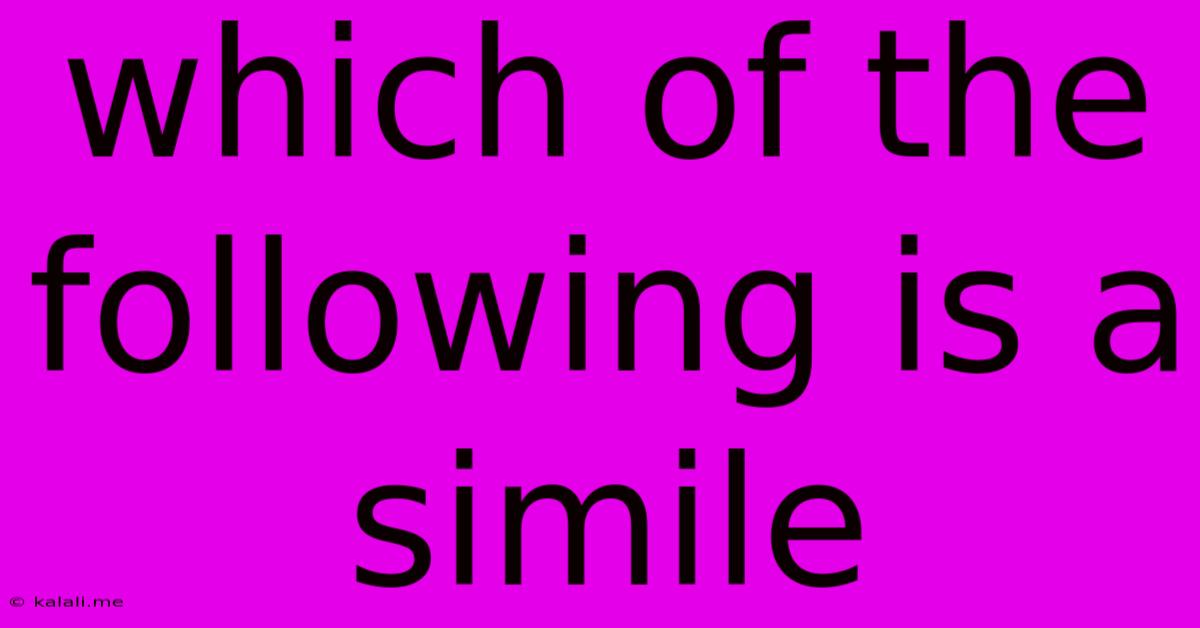Which Of The Following Is A Simile
Kalali
Jun 12, 2025 · 2 min read

Table of Contents
Which of the Following is a Simile? Understanding Figurative Language
Meta description: Learn to identify similes! This article explains what a simile is, differentiates it from other figures of speech, and provides examples to help you master this literary device. We'll explore common mistakes and offer tips for effective simile use.
Figurative language adds depth and vibrancy to writing. Among the most common figures of speech are similes, metaphors, and personification. But what exactly is a simile, and how can you distinguish it from other literary devices? This article will guide you through the process of identifying similes and understanding their effective use.
What is a Simile?
A simile is a figure of speech that directly compares two unlike things using the words "like" or "as." It creates a vivid image by drawing a parallel between seemingly disparate concepts. The comparison isn't meant to be literally true; rather, it aims to illuminate one thing by relating it to another, more familiar concept.
Simile vs. Metaphor: Key Differences
Often confused, similes and metaphors both make comparisons. However, a simile uses "like" or "as" explicitly, while a metaphor states the comparison directly without these words.
- Simile: "Her laughter was like a melodious song."
- Metaphor: "Her laughter was a melodious song."
Notice how both examples compare laughter to a song, but the simile uses "like" to make the comparison, while the metaphor equates the two directly.
Identifying Similes: Examples and Non-Examples
Let's examine some examples to solidify your understanding:
Examples of Similes:
- "He was as strong as an ox."
- "The clouds drifted like fluffy sheep across the sky."
- "Her eyes sparkled like diamonds."
- "The rain fell like a curtain."
- "He eats like a bird." (even though birds eat quite a lot!)
Non-Examples (Not Similes):
- "He is a lion in battle." (Metaphor)
- "The wind howled." (Personification)
- "The storm raged." (Personification)
- "The car is fast." (Simple statement)
- "The building is tall." (Simple statement)
Common Mistakes in Identifying Similes
A common mistake is confusing similes with other forms of figurative language. Remember, the defining characteristic of a simile is the explicit use of "like" or "as" to draw the comparison. Without these words, the comparison is usually a metaphor.
Tips for Effective Simile Use
- Choose comparisons that are unexpected but relevant. The more unique the comparison, the more memorable the image.
- Avoid clichés. Overused similes can weaken your writing. Strive for originality.
- Ensure the comparison is clear and easily understood. The goal is to enhance understanding, not confuse the reader.
- Use similes sparingly. Too many similes can make your writing feel overly flowery or contrived.
By understanding the defining characteristics of a simile and practicing identification, you'll be able to confidently distinguish similes from other figures of speech and use them effectively to enhance your writing. Remember to focus on the use of "like" or "as" as the key indicator!
Latest Posts
Latest Posts
-
Change Of State Of Matter Diagram
Jun 13, 2025
-
What Is The Difference Between Tort And Crime
Jun 13, 2025
-
Which Of The Following Is A Projective Test
Jun 13, 2025
-
What Are The Multiples Of 11
Jun 13, 2025
-
Unit Weight Of Water Kn M3
Jun 13, 2025
Related Post
Thank you for visiting our website which covers about Which Of The Following Is A Simile . We hope the information provided has been useful to you. Feel free to contact us if you have any questions or need further assistance. See you next time and don't miss to bookmark.